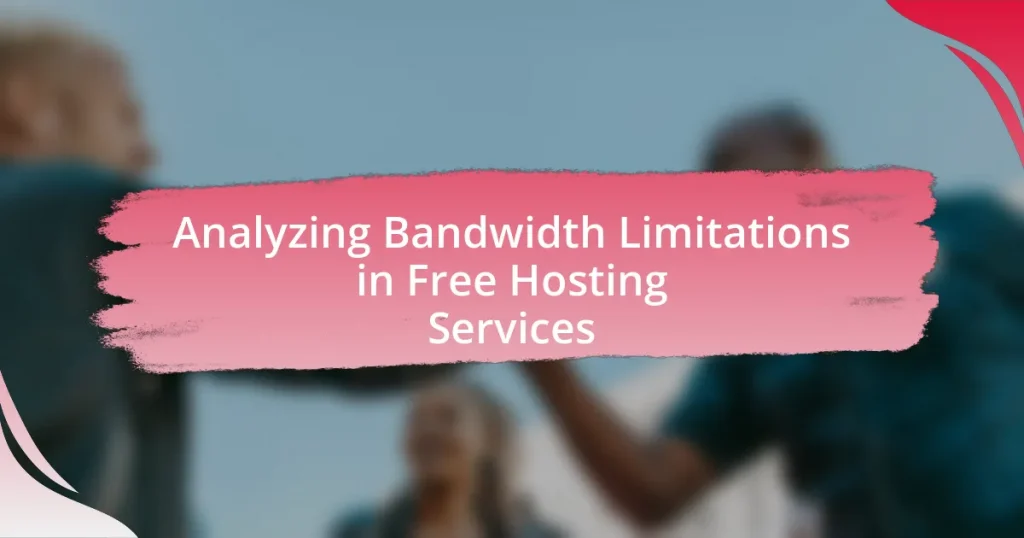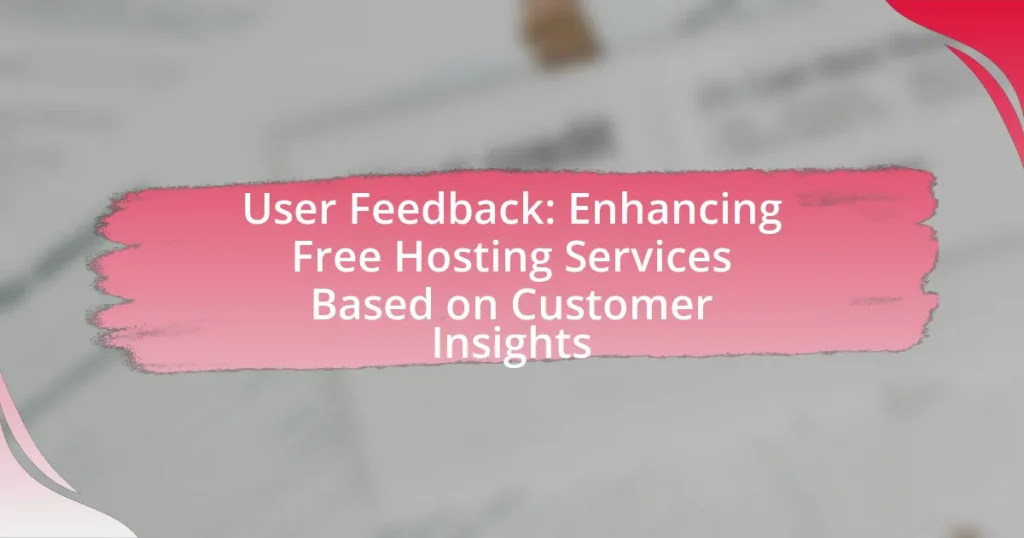Bandwidth limitations in free hosting services refer to the restricted data transfer allowed over a specified period, typically monthly, which can significantly impact website performance. These limitations, often ranging from 1 GB to 10 GB per month, can lead to slower loading times, increased latency, and potential downtime when exceeded. The article explores how bandwidth affects user experience, the metrics used to measure limitations, and the reasons free hosting services impose these restrictions. Additionally, it discusses common types of bandwidth limitations, strategies for optimizing usage, and best practices for selecting a hosting provider that meets future scalability needs.

What are Bandwidth Limitations in Free Hosting Services?
Bandwidth limitations in free hosting services refer to the restricted amount of data transfer allowed over a specified period, typically measured monthly. These limitations can significantly affect website performance, as exceeding the allocated bandwidth may result in throttled speeds or temporary suspension of the website. For instance, many free hosting providers impose caps ranging from 1 GB to 10 GB per month, which can be insufficient for websites with moderate to high traffic. This restriction is often implemented to manage server resources and maintain service quality for all users, as free hosting services typically operate on shared server environments.
How do bandwidth limitations affect website performance?
Bandwidth limitations directly reduce website performance by restricting the amount of data that can be transmitted over the internet connection. When a website exceeds its allocated bandwidth, users may experience slower loading times, increased latency, or even downtime, as the server struggles to deliver content efficiently. For instance, a study by Akamai Technologies found that a 100-millisecond delay in load time can decrease conversion rates by 7%. This demonstrates that inadequate bandwidth can significantly hinder user experience and site effectiveness, particularly for content-heavy websites.
What metrics are used to measure bandwidth limitations?
The primary metrics used to measure bandwidth limitations include throughput, latency, packet loss, and jitter. Throughput quantifies the actual data transfer rate, typically measured in bits per second, indicating how much data can be transmitted over a network in a given time frame. Latency measures the time it takes for data to travel from the source to the destination, affecting the responsiveness of applications. Packet loss refers to the percentage of packets that fail to reach their destination, which can significantly impact performance and user experience. Jitter measures the variability in packet arrival times, which can lead to inconsistent performance in real-time applications. These metrics collectively provide a comprehensive view of bandwidth limitations and their impact on network performance.
How do bandwidth limitations impact user experience?
Bandwidth limitations significantly degrade user experience by causing slow loading times and interruptions in service. When users encounter restricted bandwidth, they often experience delays in accessing content, which can lead to frustration and increased bounce rates. Research indicates that a one-second delay in page load time can result in a 7% reduction in conversions, highlighting the direct correlation between bandwidth and user satisfaction. Additionally, streaming services may buffer or fail to load entirely under low bandwidth conditions, further diminishing the overall experience. Thus, inadequate bandwidth directly affects the efficiency and reliability of online interactions, ultimately impacting user retention and engagement.
Why do free hosting services impose bandwidth limitations?
Free hosting services impose bandwidth limitations primarily to manage server resources and ensure fair usage among users. By restricting bandwidth, these services can prevent any single user from consuming excessive resources, which could degrade performance for others. This practice is essential for maintaining the stability and reliability of the hosting environment, as it allows the provider to accommodate a larger number of users without overwhelming the infrastructure. Additionally, bandwidth limitations help free hosting services control operational costs, as higher bandwidth usage typically incurs increased expenses for data transfer and server maintenance.
What are the cost implications of providing unlimited bandwidth?
Providing unlimited bandwidth typically results in higher operational costs for service providers due to increased infrastructure demands. This includes the need for more robust servers, enhanced network capacity, and greater data management resources to handle potentially unlimited data transfer. For instance, companies like Google and Amazon invest billions in data centers and network infrastructure to support high bandwidth usage, which can lead to increased costs that may be passed on to consumers or absorbed by the company. Additionally, unlimited bandwidth can lead to network congestion and require more sophisticated traffic management solutions, further escalating expenses.
How do bandwidth limitations help manage server resources?
Bandwidth limitations help manage server resources by controlling the amount of data that can be transmitted over a network within a specific timeframe. This regulation prevents server overload, ensuring that resources are allocated efficiently among multiple users. For instance, when a server has a bandwidth cap, it can prioritize essential traffic and maintain performance levels, reducing the risk of downtime or slow response times. Studies show that implementing bandwidth limitations can lead to improved user experience and resource distribution, as it allows servers to handle concurrent connections more effectively without compromising service quality.

What are the Common Types of Bandwidth Limitations in Free Hosting Services?
Common types of bandwidth limitations in free hosting services include data transfer caps, throttling, and shared bandwidth. Data transfer caps restrict the amount of data that can be transferred within a specific time frame, often measured monthly. Throttling occurs when the hosting provider intentionally slows down the connection speed after a certain usage threshold is reached. Shared bandwidth means that multiple users share the same bandwidth resources, which can lead to slower speeds during peak usage times. These limitations are implemented to manage server load and ensure fair usage among users.
What are the different bandwidth caps imposed by free hosting services?
Free hosting services typically impose bandwidth caps that range from 1 GB to 10 GB per month. For example, some services may offer 1 GB of bandwidth, which limits the amount of data that can be transferred to and from the website, while others may provide up to 10 GB, allowing for more extensive usage. These caps are designed to manage server resources and prevent abuse, as free hosting often relies on shared resources. Additionally, exceeding these limits can result in throttling or temporary suspension of the service, reinforcing the importance of understanding these restrictions when selecting a free hosting provider.
How do data transfer limits vary among free hosting providers?
Data transfer limits among free hosting providers vary significantly, with some offering as little as 1 GB per month while others may provide up to 10 GB or more. For instance, providers like InfinityFree and 000webhost typically impose limits around 5 GB, whereas platforms such as Freehostia may offer higher limits depending on the specific plan. These variations are influenced by the provider’s infrastructure, intended user base, and monetization strategies, with many free services implementing strict bandwidth caps to encourage users to upgrade to paid plans.
What is the significance of peak vs. off-peak bandwidth usage?
Peak bandwidth usage refers to the maximum data transfer rate experienced during high-demand periods, while off-peak bandwidth usage occurs during times of lower demand. The significance of understanding these two concepts lies in their impact on service performance and resource allocation in free hosting services. During peak times, users may experience slower speeds and increased latency due to network congestion, which can hinder website performance and user experience. Conversely, off-peak times typically allow for faster data transfer rates and more reliable service, as fewer users are competing for bandwidth. This distinction is crucial for optimizing resource management and ensuring that free hosting services can meet user demands effectively, particularly in environments where bandwidth is limited.
How do throttling and speed restrictions work in free hosting services?
Throttling and speed restrictions in free hosting services limit the bandwidth available to users to manage server load and ensure fair resource distribution. These services often impose caps on data transfer rates or total data usage, which can lead to slower website performance during peak times or after reaching a certain usage threshold. For example, a free hosting provider may allow a maximum of 1 GB of data transfer per month, after which the speed may be reduced significantly, sometimes to a fraction of the original speed, to prevent overuse of resources. This practice helps maintain service quality for all users, as free hosting typically attracts a large number of websites competing for limited server capacity.
What are the effects of throttling on website accessibility?
Throttling negatively impacts website accessibility by reducing the speed and performance of web pages for users. When bandwidth is limited, users experience slower loading times, which can lead to increased bounce rates and decreased user engagement. Research indicates that a one-second delay in page load time can result in a 7% reduction in conversions, highlighting the critical nature of speed for user retention. Additionally, throttling can restrict access to content, particularly for users with slower internet connections, further exacerbating accessibility issues.
How do speed restrictions influence user engagement?
Speed restrictions negatively influence user engagement by causing delays in content loading and interaction. Research indicates that users are less likely to engage with websites that load slowly; for instance, a study by Google found that a one-second delay in mobile page load time can reduce conversions by up to 20%. This demonstrates that speed restrictions can lead to higher bounce rates and lower overall user satisfaction, ultimately diminishing user engagement on platforms affected by bandwidth limitations.

How Can Users Navigate Bandwidth Limitations in Free Hosting Services?
Users can navigate bandwidth limitations in free hosting services by optimizing their website content and utilizing caching techniques. Optimizing content involves compressing images, minifying CSS and JavaScript files, and reducing the overall size of web pages, which decreases the amount of data transferred during user visits. Caching techniques, such as using browser caching and content delivery networks (CDNs), can store static resources closer to users, minimizing bandwidth usage and improving load times. These strategies are effective because they directly reduce the data load on the hosting service, allowing users to stay within bandwidth limits while maintaining website performance.
What strategies can users employ to optimize bandwidth usage?
Users can optimize bandwidth usage by implementing data compression techniques, scheduling downloads during off-peak hours, and utilizing content delivery networks (CDNs). Data compression reduces the size of files transmitted over the network, which can significantly decrease bandwidth consumption; for instance, using Gzip compression can reduce file sizes by up to 70%. Scheduling downloads during off-peak hours takes advantage of lower network traffic, allowing for faster speeds and less congestion. Additionally, CDNs distribute content closer to users, minimizing latency and bandwidth usage by caching static resources, which can lead to improved load times and reduced data transfer costs.
How can website design impact bandwidth consumption?
Website design significantly impacts bandwidth consumption through factors such as image sizes, the use of multimedia, and the complexity of code. For instance, large images and videos can drastically increase the amount of data transferred when a user accesses a website, leading to higher bandwidth usage. According to a study by Google, optimizing images can reduce page load times by up to 80%, which directly correlates to lower bandwidth consumption. Additionally, websites with excessive scripts and complex layouts require more data to render, further increasing bandwidth needs. Therefore, efficient website design that prioritizes minimalism and optimization can effectively reduce bandwidth consumption.
What tools can help monitor bandwidth usage effectively?
Tools that can help monitor bandwidth usage effectively include PRTG Network Monitor, SolarWinds Bandwidth Analyzer Pack, and NetFlow Analyzer. PRTG Network Monitor provides real-time bandwidth monitoring and alerts, allowing users to track usage across various devices and applications. SolarWinds Bandwidth Analyzer Pack offers detailed insights into bandwidth consumption and network performance, utilizing flow data for accurate analysis. NetFlow Analyzer specializes in traffic analysis and reporting, enabling users to visualize bandwidth usage patterns over time. These tools are widely recognized for their effectiveness in managing and optimizing bandwidth in various network environments.
What are the best practices for selecting a free hosting service with favorable bandwidth policies?
To select a free hosting service with favorable bandwidth policies, prioritize providers that explicitly state their bandwidth limits and offer unlimited or high data transfer allowances. Research user reviews and comparisons to identify services that have a reputation for reliable bandwidth without throttling. Additionally, check for transparency in their terms of service regarding bandwidth usage, as some providers may impose hidden restrictions. According to a 2021 survey by HostingAdvice, 70% of users reported dissatisfaction with bandwidth limitations in free hosting, highlighting the importance of thorough evaluation before selection.
How can users compare bandwidth offerings among different providers?
Users can compare bandwidth offerings among different providers by evaluating key metrics such as speed, data caps, and pricing structures. To effectively assess these offerings, users should look for specific details like the maximum download and upload speeds advertised by each provider, as well as any limitations on data usage per month. For instance, a provider may offer 100 Mbps download speed with a 1 TB monthly data cap, while another may provide 50 Mbps with unlimited data. Additionally, users can utilize online comparison tools and customer reviews to gauge real-world performance and reliability, which can further inform their decision.
What should users look for in terms of scalability and future needs?
Users should prioritize flexible resource allocation and upgrade paths when considering scalability and future needs in free hosting services. Flexible resource allocation allows users to adjust bandwidth, storage, and processing power as their requirements grow, ensuring that the service can accommodate increased traffic or data demands. Upgrade paths are crucial because they provide a clear transition to paid plans or enhanced features, which is essential for businesses anticipating growth. According to a study by HostingAdvice, 70% of users reported that the ability to scale their hosting services was a key factor in their decision-making process, highlighting the importance of these features in long-term planning.
What troubleshooting tips can help users deal with bandwidth limitations?
To deal with bandwidth limitations, users should first identify bandwidth-heavy applications and limit their usage. Monitoring network activity can reveal which applications consume the most bandwidth, allowing users to prioritize essential tasks. Additionally, users can optimize their internet connection by using wired connections instead of Wi-Fi, as wired connections typically provide more stable speeds. Implementing Quality of Service (QoS) settings on routers can also help prioritize bandwidth for critical applications. Furthermore, users should regularly check for firmware updates on their routers, as updates can improve performance and security. Lastly, scheduling large downloads or updates during off-peak hours can help manage bandwidth more effectively.
How can users identify bandwidth bottlenecks on their websites?
Users can identify bandwidth bottlenecks on their websites by utilizing performance monitoring tools that analyze traffic patterns and resource usage. These tools, such as Google Analytics, can provide insights into page load times, user behavior, and server response times, which are critical indicators of bandwidth issues. For instance, if a website experiences slow loading times during peak traffic hours, it suggests that the available bandwidth is insufficient to handle the volume of users. Additionally, tools like Pingdom or GTmetrix can perform speed tests and pinpoint specific elements that may be consuming excessive bandwidth, such as large images or unoptimized scripts. By regularly monitoring these metrics, users can effectively identify and address bandwidth bottlenecks.
What steps can be taken to mitigate the effects of bandwidth limitations?
To mitigate the effects of bandwidth limitations, users can implement several strategies. First, optimizing website content by compressing images and minimizing file sizes reduces the amount of data transmitted, which is crucial for bandwidth conservation. According to a study by Google, optimizing images can lead to a reduction in page load time by up to 80%, significantly easing bandwidth strain.
Second, utilizing content delivery networks (CDNs) can distribute content across multiple servers, reducing the load on a single server and improving access speed for users. Research from Akamai indicates that CDNs can enhance website performance by up to 50% during peak traffic times.
Third, scheduling heavy data transfers during off-peak hours can prevent congestion and ensure smoother performance. A report from the Federal Communications Commission (FCC) highlights that bandwidth usage typically peaks in the evenings, suggesting that off-peak scheduling can effectively manage bandwidth limitations.
Lastly, implementing caching strategies allows frequently accessed data to be stored locally, reducing the need for repeated data transfers. According to a study by the University of California, caching can decrease bandwidth usage by up to 70% for frequently visited sites.















